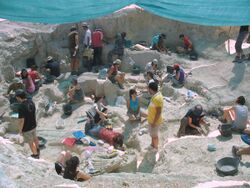Biology:Cerro de los Batallones

File:On-the-Socio-Sexual-Behaviour-of-the-Extinct-Ursid-Indarctos-arctoides-An-Approach-Based-on-Its-pone.0073711.s005.ogv Cerro de los Batallones (Hill of the Battalions) is a hill at Torrejón de Velasco, Madrid, Spain where a number of fossil sites from the Upper Miocene (MN10) have been found.[1][2][3] Nine sites have been discovered with predominantly vertebrate fossils, invertebrates and plants being less represented. The first deposits were discovered accidentally in July 1991.
Batallones-10 (B-10) is considered to contain the oldest representative of fossils.[3]
Fossils
Nearly the entire proportion of fossils of Batallones-1 were of Carnivorans.[4] The species of sabre-tooth cat known as Promegantereon ogygia and Machairodus aphanistus (the first complete skull)[5] were found at B-1,[6] as was Simocyon a type of red panda.[7] In regards to the saber-tooth cats, Batallones-1 represents an ideal site for recording the percentage of specimens for which breakage of the upper canines occurred. Promegantereon, Machairodus and Paramachairodus are perfect examples of this at Batallones; fossils indicate a high number of canine breaks from where the teeth hit the bones of a struggling victim, indicating these early machairodonts would use their elongated teeth to subdue prey as modern big cats do.[8]
A new species of Hispanomys (Rodentia) was found at various sites.[3] A new species of Micromeryx (deer) was found at B-1 and B-10.[9]
Fauna
Below is a list of notable fossil genera from Cerro de los Batallones.[10]
Artiodactyla
- †Microstonyx
- †Boselaphine antelopes
- †Decennatherium rex
- †Micromeryx flourensianus
Carnivora
- †Ammitocyon kainos[11]
- †Amphicyon major
- †Eomellivora piveteaui
- †Indarctos arctoides
- †Leptofelis vallesiensis
- †Machairodus aphanistus & M. alberdiae
- †Magericyon anceps & M. castellanus
- †Promegantereon ogygia
- †Protictitherium crassum
- †Simocyon batalleri
Perissodactyla
- †Aceratherium incisivum
- †Hippotherium primigenium
- †Hispanotherium matritense
Proboscidea
Rodentia
- †Hispanomys
See also
Notes
- ↑ Domingo et al. 2011
- ↑ Morales, Alcalá & Álvarez-Sierra 2004
- ↑ 3.0 3.1 3.2 López-Antoñanzas et al. 2010
- ↑ Peigné et al. 2008
- ↑ Antón et al. 2004
- ↑ Salesa et al. 2006
- ↑ Peigné et al. 2005
- ↑ Anton, Mauricio (2013). Sabertooth.
- ↑ Sánchez, Domingo & Morales 2009
- ↑ Antón, Mauricio (2013). Sabertooth. Bloomington, Indiana: University of Indiana Press. p. 52. ISBN 9780253010421.
- ↑ Morales et al. 2021[1]
References
- Domingo, MS; Domingo, L; Sánchez, IM; Alberdi, MT; Azanza, B; Morales, J (January 2011). "New Insights on the Taphonomy of the Exceptional Mammalian Sites of Cerro de los Batallones (Late Miocene, Spain) Based on Rare Earth element Geochemistry". PALAIOS 26 (1): 55–65. doi:10.2110/palo.2010.p10-047r.
- López-Antoñanzas, R; Peláez-Campomanes, P; Álvarez-Sierra, MA; García-Paredes, I (December 2010). "New species of Hispanomys (Rodentia, Cricetodontinae) from the Upper Miocene of Batallones (Madrid, Spain)". Zoological Journal of the Linnean Society 160 (4): 725–47. doi:10.1111/j.1096-3642.2010.00618.x.
- Antón, M; Salesa, MJ; Morales, J; Turner, A (2004). "First known complete skulls of the scimitar-toothed cat Machairodus aphanistus (Felidae, Carnivora) from the Spanish late Miocene site of Batallones-1". Journal of Vertebrate Paleontology 24 (4): 957–969. doi:10.1671/0272-4634(2004)024[0957:FKCSOT2.0.CO;2].
- Morales, J; Alcalá, L; Álvarez-Sierra, M (June 2004). "Paleontología del sistema de yacimientos de mamíferos miocenos del Cerro de los Batallones, Cuenca de Madrid". Geogaceta (35). https://www.researchgate.net/profile/Victoria-Quiralte/publication/236167244_Paleontologia_del_sistema_de_yacimientos_de_mamiferos_miocenos_del_Cerro_de_los_Batallones_Cuenca_de_Madrid/links/02e7e5177b83f3d2da000000/Paleontologia-del-sistema-de-yacimientos-de-mamiferos-miocenos-del-Cerro-de-los-Batallones-Cuenca-de-Madrid.pdf.
- Peigné, S; Salesa, MJ; Antón, M; Morales, J (2005). "Ailurid carnivoran mammal Simocyon from the late Miocene of Spain and the systematics of the genus". Acta Palaeontologica Polonica 50 (2): 219–238. OCLC 716595914. http://www.app.pan.pl/archive/published/app50/app50-219.pdf.
- Peigné, S; Salesa, MJ; Antón, M; Morales, J (July 2008). "A New Amphicyonine (Carnivora: Amphicyonidae) from the Upper Miocene of Batallones-1, Madrid, Spain". Palaeontology 51 (4): 943–65. doi:10.1111/j.1475-4983.2008.00788.x.
- Salesa, MJ; Antón, M; Turner, A; Morales, J (March 2006). "Inferred behaviour and ecology of the primitive sabre-toothed cat Paramachairodus ogygia (Felidae, Machairodontinae) from the Late Miocene of Spain". Journal of Zoology 268 (3): 243–254. doi:10.1111/j.1469-7998.2005.00032.x.
- Sánchez, IM; Domingo, MS; Morales, J (2009). "New data on the Moschidae (Mammalia, Ruminantia) from the upper Miocene of Spain (Mn 10–Mn 11)". Journal of Vertebrate Paleontology 29 (2): 567–575. doi:10.1671/039.029.0223.
[ ⚑ ] 40°10′19.78″N 3°42′51.42″W / 40.1721611°N 3.7142833°W
 |

